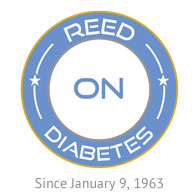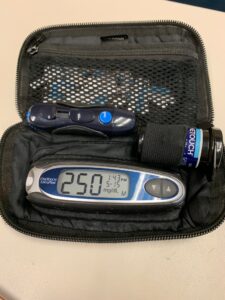Early in the 1980s, the development of blood glucose meters provided immediate data and feedback about my blood sugars. But what was I supposed to do when my blood sugar was still high several hours after eating?
I knew that insulin would lower blood sugar, so I started experimenting with the amounts. You can imagine how that turned out.
Yep … sometimes I was lucky and my blood glucose levels returned to a normal range. But many times my blood sugar levels would move too low and I’d end up searching – quickly – for something to eat. And the process would start itself over.
I shared my attempts at correcting post meal blood sugars with a new endocrinologist, Paul Davidson, after my move to Atlanta. He smiled, asked for my log of blood sugars and then pulled out a hand calculator. After several minutes, he said:
“Here’s a formula that will calculate the amount of insulin you need to correct high blood sugars.”
“Really? How does it work?”
“For you, 1 unit of insulin will bring your blood sugar down 50 points (in the U.S. a point is milliliter/deciliter).
I sat there in wonderment that this kind of personalized formula was available. Before I could ask any questions, Dr. Davidson went on:
“You can also calculate the dose for meals, but you will use a different formula. For you, inject 1 unit of Regular Insulin for 15 grams of carbohydrates.”
“So, if I eat a dinner that has 60 grams of carbohydrates, I inject 4 units of Regular before the meal?
“Yes, that’s how it works.”
Holy calculator batman! I asked what this formula was called and he called it a personalized sliding scale.
You know what? It worked reasonably well. It was so much better than my efforts of trial and error at correcting high blood sugars. And I started to eat a variety of foods and became an expert in estimating carbohydrates. (Prior to that, I was injected a standard amount of insulin for all meals.)
Was it perfect? No. The formula didn’t account for things like exercise, stress and foods high in fat (such as pizza). Also, one formula didn’t seem to work for different times of day.
But it was a huge step forward. I’m thankful for the confidence that these personalized formulas provided when determining how much insulin to give. The number of lows I experienced was reduced and my quality of life improved.


